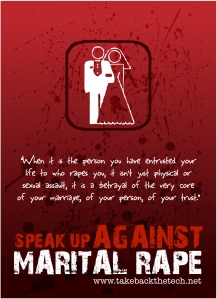 Marital or spousal rape is rape committed by one spouse against the other. This type of rape has been controversial in the modern era because of the historical assumption that marriage takes away the woman’s right to refuse to have sex.
Marital or spousal rape is rape committed by one spouse against the other. This type of rape has been controversial in the modern era because of the historical assumption that marriage takes away the woman’s right to refuse to have sex.
As you read the following paragraphs, you may think to yourself, “Where did this information come from? What’s the source?” There are so many sources on this subject that I’ve chosen to list a number of them at the end of this post rather than insert them within the text.
The “ownership” view that rape couldn’t exist within marriage was upheld in British and American common law for a long time, based on legal opinions such as this: “But the husband cannot be guilty of a rape committed by himself upon his lawful wife, for by their mutual matrimonial consent and contract the wife hath given up herself in this kind unto her husband which she cannot retract” (Sir Matthew Hale’s History of the Pleas of the Crown, 1736).
Additionally, even atheists will point to the Bible as an example of “common sense”: “The wife’s body does not belong to her alone but also to her husband. In the same way, the husband’s body does not belong to him alone but also to his wife. Do not deprive each other except by mutual consent and for a time, so that you may devote yourselves to prayer. Then come together again so that Satan will not tempt you because of your lack of self-control” (1 Corinthians 7:4-5, NIV).
They interpret this to mean that neither spouse can ever say no to sex — and in an ancient patriarchal culture, the real effect was to give the husband sexual autonomy but not the wife.
Conveniently, people often skip the very next verse, verse 6: “I say this as a concession, not as a command.” They also skip over the numerous passages throughout the Bible regarding the mutual love, respect, understanding, and gentleness that are actually supposed to characterize marriage.
Even today, when laws against marital rape exist in all 50 states–historically a very recent development–the cultural assumption of sexual “ownership” presents a massive barrier to better laws and enforcement, and to providing support and care for victims of marital rape. The reflexive, unthinking assumption is that when two people get married, the wife no longer has a right to say “no” or to own and control her body.
Commenters on the Internet are quite frank: “If she didn’t want to have sex, she should’ve have gotten married.” Assumption: When a woman takes marital vows, she gives up her free agency, sexual autonomy, and sexual power of choice as a human being forever. Or until divorce.
The more “civilized” version pressures women to simply “choose” to not have a choice — to always have sex according to her spouse’s will — and then crows that the woman has made this choice herself. This is not genuine free choice either.
Both spouses should be able to say No to each other. Both spouses should respect the other person’s No and not punish them emotionally or physically for it. Spouses who are not free to say No are not free to fully love.
Today, when we have the benefit of more knowledge and of studies on the subject, we also know that men don’t always want sex either. I’ve focused on women not because rape of husbands doesn’t happen (it’s rare, but it does happen), but because historically the husband’s sexual agency and his ability to say No, own his body, and set his own sexual agenda were not interfered with. In general, married men still had control over their bodies; married women explicitly did not.
Here are key facts about marital rape law and the realities of marital rape.
- Until 1976, rape laws in all 50 states contained a Marital Rape Exemption specifically to prevent husbands who raped their wives from being charged with a crime.
- As of 1996, only 17 states and the District of Columbia had abolished this exemption completely.
- While all 50 U.S. states have laws against marital rape, 33 of the states consider marital rape a lesser crime than other types of rape–typically they charge the attacker with spousal abuse or battery instead of rape.
- Studies show that marital rape is the most common type of rape. Ten to 14 percent of all completed rapes are committed by husbands or ex-husbands, and in keeping with rape reporting statistics nationwide, experts believe this is an underestimation of the actual incidence of marital rape.
- Marital rape involves extreme trauma. Many people consider marital rape less traumatic than other types of rape, but studies show the opposite is true (see this example of information, and there’s plenty more with a simple Internet search or your local library). Being raped by a spouse is a betrayal of one’s trust, one’s humanity, and of the relationship. This is a whole other level of trauma not found in stranger rape or even date rape–our trust in a stranger or a date is far less to begin with, and our personal investment in them minimum to none.
- Victims of marital rape have very little of the support that other rape victims can access. Many people around the victim may not believe it was rape at all. Victims of marital rape, far more than victims of other types of rape, find themselves having to cope in nearly total isolation.
- It wasn’t until 1993 that marital rape nationally became a crime in the United States. For many years the U.S. legal system allowed a loophole in the marital rape law having to do with whether the spouses were actually living together at the time of the rape. If they were, the perpetrator got off. Additionally, when it’s already so difficult to secure a rape conviction for any type of rape, convicting rape within a marriage based on evidence is vanishingly unlikely.
- One of the most common myths about marital rape is that it happens when the wife withholds sex from her husband. Research and evidence demonstrates decisively that the wife’s withholding sex is not the cause of, and doesn’t lead to, marital rape. Interviews with attackers and other evidence have all pointed to marital rape as a demonstration of control and power or an outlet for the attacker’s rageaholism.
Bottom line for both spouses: How much respect and autonomy and ownership of your own body do you want? Give that same level to your spouse. Let’s be clear: We’re not saying to demand as much sex from your spouse as you want yourself. We’re saying to extend to your spouse the same level of self-ownership and freedom you want your spouse to extend to you. Full agency = full love relationship. There are no shortcuts.
Helpful sources of information include:
If you’re a victim of marital rape, you can access the same social services resources as all other rape victims. (See this earlier post on what to do if you’re raped. Also check the blogroll on this blog for RAINN, AARDVARC, and other resources for domestic violence and sexual assault.)
Be aware that individual members of law enforcement may still harbor prejudice about marital rape and may even encourage you not to report or not to get evidence collected at the hospital. Please don’t let this stop you. Someone has committed a rape against you, and that’s a crime–you have every right to protect yourself, gather evidence, and get help.
If you’ve forced sex on your spouse, whether by verbal pressure or threats, brandishing a weapon, or physical violence–get help now! Don’t do it even one more time. Contact any rape support group or resource, and they’ll willingly point you to the help you need. Or contact SHARPP in the list above and check the resource list at the end.
Filed under: domestic violence, for men, get safe: rape, sexual assault, sexual assault info | Tagged: domestic violence, Initiatives to prevent sexual violence, marital rape, Marriage, rape, rape law, rape statistics, sexual assault, spousal rape, women | 14 Comments »






You must be logged in to post a comment.